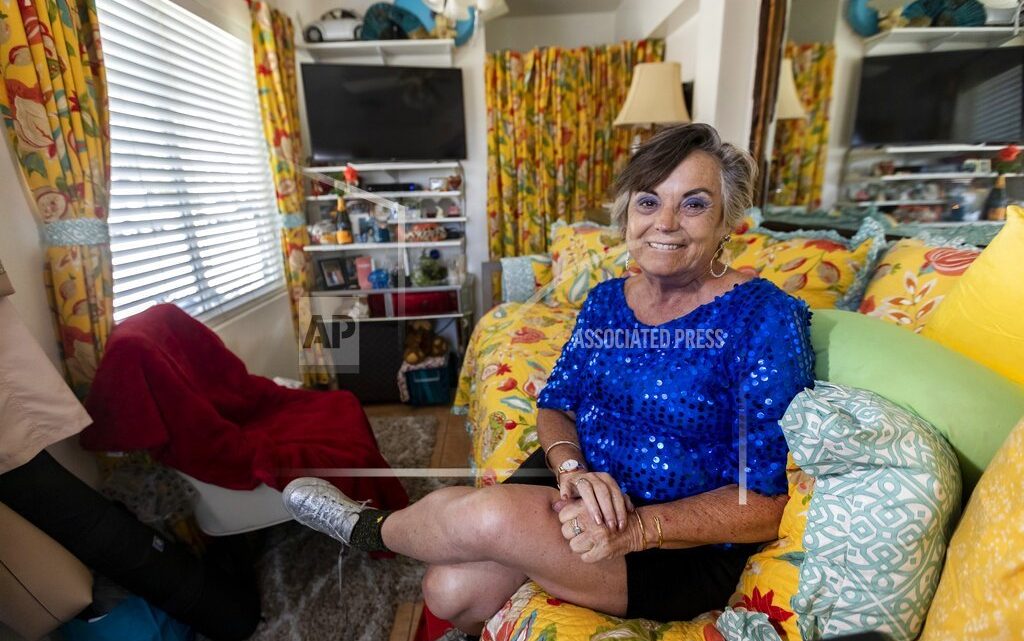Cost of living in Keys goes up as home size goes down
By GWEN FILOSA Miami Herald
MIAMI (AP) — Miami-Dade is the most expensive metro in the U.S. for renters and one of the costliest for home buyers. This series explains why that’s so and what it means for the region and its residents. Our interactive tool helps renters and buyers match their budgets to affordable neighborhoods. Future stories will explore solutions to South Florida’s housing crisis.
Dotti Clifford lives the tiny life in Key West.
She has a tiny fridge. A tiny bed. A tiny bathroom. A tiny two-burner stove and a daybed. A tiny lampshade that does double duty as an earring holder.

Dotti Clifford sits in her home in Key West, Fla. The home, which is roughly 100-square-feet in size, has allowed her to live in an otherwise expensive neighborhood. (Matias J. Ocner/Miami Herald via AP)
Everything is squeezed into a tiny apartment of 100 square feet, formerly the front porch of an Old Town house.
All this tiny is how the 61-year-old Clifford, who relies on Social Security to pay her rent, affords to live in paradise.
She pays $850 a month. She considers that a bargain in pricey Key West, and is grateful for it.
“I still get so excited. I can’t believe I live here,” Clifford said.
An upbeat survivor of pancreatic cancer, her standing answer to “How are you?” is “I’m twist-and-shout happy!” As for living tiny, she said, “You have so much freedom to live out in the world.”
Living in the Florida Keys either means giving up space or getting squeezed out of town. Housing costs have soared for years. But Hurricane Irma in September 2017 has hit Monroe County even harder, reducing rentals in the Middle and Lower Keys.
In order to stay in the Keys, more people have had to go small.
Rents in Key West, which was spared the agony of Irma, simply rose to meet the demand and grew as they have since 2011, when a studio or room generally went for $850 a month. The same room or studio now rents for $1,300 to $1,600.
The median rent for an efficiency, or studio, in Key West is $1,575 and “low” rent is $1,235, according to Monroe County’s latest limits on affordable housing units. The median one-bedroom home goes for $1,765, but if you look on Facebook, studios are going for as much as $2,000 and one-bedrooms for $2,500.
According to the latest U.S. Census figures, the median household income in Key West is $62,052. In Key Largo, which is unincorporated Monroe County, it’s $61,650. Median gross rent — rent combined with monthly expenses like taxes and utilities — in Key West is $1,701, according to the Census. In the Upper Keys, it’s $1,375.
Count Dotti Clifford among the people who have learned to live in tiny living spaces, sometimes smaller than 200 square feet, in order to afford living in expensive Key West. The housing crisis has made it hard for people to stay in the Keys without roommates or moving into a trailer.
More than 4,000 homes throughout the Keys were destroyed or had major damage from Hurricane Irma, according to a Monroe County memo released this year called “Post Hurricane Irma Disaster Recovery Housing Repair and Reconstruction Funding and Strategies.”
Of these, the hardest hit were the mobile homes, manufactured homes and RVs, with 378 suffering major damage and 666 destroyed. According to a damage summary released by the county, Monroe’s number of total housing units went from 41,569 to 40,389 after Irma. Of those not completely destroyed, 2,974 suffered major damage, summary figures show.
Many of the destroyed residences made up the affordable/workforce housing stock serving the thriving economy of the Florida Keys.
So, in Key West and along the entire island chain, residents are learning to make do. That includes renting a room in someone’s house and abiding by the house rules: no overnight guests, no pets, no noise, no this and no that.
“You learn to live like a teenager,” said Michele Rodriguez, 45, who has a room and a bathroom that costs less than market rate, which is around $1,200 elsewhere in Key West.
Rodriguez is from the Bay Area and spent some time living in Melbourne, Australia, so she knows all about expensive housing. She found her place in Key West by word of mouth.
Rodriguez chooses to live with a makeshift mini-kitchen in her single room so she can spend her money on her high-rent business, Next Hot Yoga.
Despite the space crunch, Rodriguez finds humor in her home life.
“The joke is, I own a business but I don’t own a mattress,” she said. “I don’t want to get too comfortable there.”
Is it worth it?
“It’s the only way,” Rodriguez said. “I got the cheapest on the island and that was dumb luck.”
And a studio in Key West can range from a single room to a place in which a George Foreman grill and mini-fridge serves as a kitchen.
Brian Eversole and his girlfriend Jocelyn Burdick share a 400-square-foot apartment with their dog, Kaimana.
Eversole has lived on and off in Key West for 19 years. He’s moved back four times.
Key West is second to none when it comes to community — and also food, music and the blue water, he said.
“I love warm and tropical,” he said. “I keep trying to find some place else and I always feel like coming home. I feel like I grew up here in a sense. The people in this town are great, it’s always been a huge family.”
As expensive and hard as it can get, Eversole said he’s always been able to make it work financially. He’s operations manager at Lazy Dog, a kayak and paddle board tour company.
Lizzy Hoke lives in fewer than 200 square feet in a second-floor apartment of an Old Town house. The first floor has an apartment that the landlords rent on Airbnb. They keep her rent low by Key West standards.
Hoke and Rodriguez, like Clifford, pay an under-market rent that’s considerably less than the customary average of $1,200 a month or higher for their spaces. Neither wanted to publicly disclose what they pay each month.
Hoke’s home includes a loft double bed so she can have some storage and her desk underneath.
Hoke, who runs an organic food store and restaurant in Key West, wasn’t sure she could live in such a small place when she first saw it. But with some creativity, and gratitude for being able to live alone on the island, she learned that she could. The loft bed gives her more space.
She just has to be careful going to bed so that she doesn’t smack her head on the ceiling fan blades.
“I have everything I need here,” Hole said. “I’ve learned to relax and appreciate what I have and make the most of it.”
Tony Hughes, who rents a stand-alone cottage in the Bahama Village neighborhood, doesn’t even want to know the measurements of his place.
Just call it small, he said.
“It suits one person,” said Hughes, 43, a boat captain who has lived in Key West since 2007. “It would be hell with two people. It’s definitely all I could afford.”
The place has a small kitchen. But the shower is outside. He pays $1,300 a month.
“It’s enough for a queen-sized bed, a TV, a dresser and a clothes rack,” he said of the space.
A closet? No room for that. Hughes had to give up a lot of stuff so he could live there.
Years ago, Hughes and eight friends rented a three-bedroom place for $1,850 a month. It was a crash pad for the crew of workers. But those days are long gone. He’s older, too, and prefers his own private space.
Hughes has a handwritten lease. It was a handshake deal, he said. The owner recently died, though, and he wonders if he’s living on borrowed time.
“I’m in my 40s. I’m too old for roommates,” he said.
Affordability for the working class gets a little easier outside Key West and the farther one gets up the 120-mile island chain.
But living anywhere in the Keys is expensive compared with the mainland, especially for places bigger than a small room.
Many workers in the Upper Keys, Key Largo and Tavernier, choose to live in South Miami-Dade and commute down the 18 Mile Stretch of U.S. 1 to work.
The median sales price for a three-bedroom house in Key Largo is $765,000, according to the real estate website Trulia. The same size house in Homestead, about 20 miles to the north, is $250,000.
Michele Barry, 43, has been teaching language arts and exceptional student education at Key Largo School since 1998, but has never lived in the Keys.
“All in all, knowing that a single teacher’s salary is not enough to ever be a homeowner in the Keys has probably been the most discouraging part,” Barry said.
Barry and a friend were hired shortly after she graduated from Florida State University. They were a at job fair in Tallahassee, where school districts from across the state had booths. Monroe County had a booth too, but she didn’t think there was much chance of getting hired as a teacher in the Keys.
“I imagined applying to Miami, Broward, and as far away as West Palm if needed,” Barry said. “Back then, teaching in the Keys was seen as a dream job.”
But, it turned out, Monroe had a demand for teachers, and there were at least eight open positions at Key Largo School alone, a pleasant surprise for Barry since her parents lived in Miami-Dade and she could commute for the first few years.
“When my college friend and I saw the Monroe County booth, we did not think they would even talk to us,” she said. “Both my friend and I signed contracts with the county, and later were both hired for Key Largo School.”
“I was especially relieved that my daily commute would only be a 50-mile drive from my parents’ house,” she said.
After a few years of living with her parents and then renting in Homestead, Barry wanted to buy her own home. But, she knew she couldn’t do it in the Keys.
“In 2003, as a single teacher, I was approved for a mortgage up to $125,000. I also knew if I wanted more than peanut butter and jelly to eat, I better stay under $110,000,” she said. “In Homestead, you could find a variety of two- to three-bedroom condos for sale. In the Keys, I had a hard time finding land for sale that was in my price range.”
Just as in Key West, the struggle to find an affordable place to live in the Middle and Upper Keys worsened after Irma.
“Although we did not see the destruction that the Lower Keys experienced, we have found that in the rebuilding process, coupled with the loss of some low-end housing, the cost of rent in the Upper Keys has increased significantly,” said the Rev. Kerry Foote, pastor of Burton Memorial United Methodist Church located in a part of unincorporated Monroe County known as Tavernier, which is in between Key Largo and the Village of Islamorada.
Foote’s church runs a food pantry that feeds poorer residents in the area, which he said has become busier over the almost two years since the storm.
“We have seen an increase in those that need to use the pantry due to the increase in rent for those fortunate enough to find rental housing,” Foote said.
Unlike the tiny homes in the Southernmost City, many workers in the Upper Keys rent downstairs enclosures beneath stilt houses, although many of these living spaces are against county code.
Many others had lived in trailer parks. But two of the largest mobile home communities, San Pedro RV and Resort and Sea Breeze Resort, which were situated side by side on the ocean side of mile marker 87 in Islamorada, were destroyed by Irma’s storm surge.
The company that owns them, Sun Communities, plans to rebuild, but the mobile homes that were there aren’t coming back. They will be replaced by small, prefab homes that meet the Village of Islamorada’s storm code and will be elevated to federal flood standards. The county is enforcing similar rules in other areas of the Keys, like Big Pine Key, where large numbers of mobile homes were destroyed in Irma.
“We lost a good number of mobile homes. Some of our zoning does not allow them to be rebuilt,” said Assistant County Administrator Christine Hurley.
The county has several plans it hopes will help result in more affordable housing that also is resilient enough to weather storms like Irma. This includes obtaining state and federal funding to repair existing homes, to completely replace them and to build entirely new communities, Hurley said.
“Newly repaired and constructed homes will be safer and better suited to survive future storms and create affordable, workforce housing options to stabilize economic viability,” county staff stated in the post-Hurricane Irma memo.
Hurley said that after witnessing the beating many mobile homes took during Irma, the county allowing them to be replaced with more mobile homes would be irresponsible.
“I never want to see what happened again. Yes, it’s affordable, but It’s not a safe product,” she said.
Much of the money for the county’s proposed projects will come out of a $90 million grant from the Florida Department of Economic Opportunity. More than half of that money, $50 million, is earmarked for housing, repair, replacement and elevation in the Florida Keys, Hurley said.
Monroe officials want to use some of the $30 million from the Florida Housing Finance Corporation to acquire Keys land where they want to build new workforce housing, according to the county memo. Three existing trailer parks have been identified as sites.
These include Howard Haven Trailer Park on Big Pine Key. Buying the park will cost about $1.5 million, and construction costs are estimated to be $4 million, according to the memo. Also identified is the Conch Key Trailer Park, which the memo states can be bought for $800,000 and rebuilt for $2.5 million. The memo also refers to a “Key Largo Site Development,” which does not specify the exact location, with a construction cost of $1.5 million.
Non-profits, like Habitat for Humanity of the Upper Keys, are also building housing for Keys workers and their families. It broke ground on what it calls the “largest project in our affiliate’s history” in August. The 16-unit attached housing development is scheduled to open by 2020.
“This is going to be by far the most affordable option in town,” Jack Niedbalski, executive director of Habitat of the Upper Keys, said at the time of the groundbreaking of Habitat of Windley Point.
Meanwhile, the county is focusing much of its efforts on smaller, detached affordable housing units with the goal of encouraging private developers to follow suit.
“We’re hoping these projects spark people to think about doing smaller housing units on site,” Hurley said. “If we do a demonstration project, maybe that will help.”
As part of its goal to reduce the amount of housing susceptible to hurricane damage, the county announced this month a state-funded program to buy homes in properties located in parts of the island chain most at risk of flooding.
The state allocated $10 million to the program in which property owners can sell their homes and land to the state at the “pre-Hurricane fair market value,” Kristen Livengood, Monroe County’s spokeswoman, said in a July 16 press release.
Priority will be given to low- and moderate-income areas, Livengood said. Homes and buildings on the purchased properties will be demolished, “and the property will be used as permanent open space, conservation, recreational, or stormwater management systems in perpetuity,” she said.
___
Information from: The Miami Herald, http://www.herald.com




I’m increasingly wondering where the service industries are going to find workers after the wealthy have finally gentrified them out of these areas.
I agree, if the Service industry employees cannot afford the housing it’s far more cost effective to move out and work at other areas in Miami and up the Coast.
Husband’s and I have burial plots in Key West. We were planning to sell our home and retire/rent. There doesn’t seem to be any provisions for new retirees.